Study behavioral objectives 38-39 and read the pages in your text indicated by E-18.
You have seen that the first phase of photosynthesis, photolysis, produces waste oxygen and two kinds of products which are available for the second phase of photosynthesis. In this chapter we will investigate the dark reactions which produce the carbohydrate product of photosynthesis. These reactions make up the process of carbon dioxide fixation. TPNH2 = NADPH

This illustration shows the appearance of the closed box of photosynthesis at the conclusion of the light reactions.
You will remember that the light dependent reactions studied in the previous web pages (photolysis and direct ATP production) required the absorption of light energy. Carbon dioxide fixation, the second phase of photosynthesis, does not require light energy and therefore can occur in the light or dark. Because of their independence from light, the chemical reactions of carbon dioxide fixation are termed dark reactions.
1. How do light reactions and dark reactions differ?
Click here to check answer. click
The dark reactions like the Kreb cycle and glycolysis is a series of chemical reactions which occur in a step by step process. During each step an organic molecule is converted to a different molecule associated with an energy change. As the various steps are presented on this "web page", list them in your notes indicating the changes in biological energy. These steps will resemble a "road map" showing changes in organic molecules and the involvement of biological energy. The two forms of chemical biological energy involved during these reactions are ATP and NADPH + H.
Upon completion of this "road map", draw a input/output box in your notes indicating what enters and leaves this pathway. Include the organic molecules and the biological energy.
Like glycolysis the dark reactions involves a cycle. That is
one of the reactants used at the beginning of the process will not be used
up but recycled.
Melvin Calvin at the University of California was curious about the fate of the carbon dioxide which was used in the dark reactions of photosynthesis. Calvin knew that somehow this bon dioxide was "fixed" into the final product molecule of carbohydrate, but exactly how this happened was a "closed box mystery." He and his associates began to find out how the carbon dioxide fixation took place.
Calvin thought that more than one chemical reaction -- perhaps even a series of reactions -- must be necessary for the process of fixation to take place. He reasoned that a plant could be give radioactive carbon dioxide at a particular time and then quickly killed. If a series of reactions were occurring, the carbon dioxide should be "stopped" somewhere in the set of reactions. By analyzing the compounds in the plant's cells, he would be able see what molecules in the cell had incorporated the radioactive carbon dioxide.
Calvin tried his idea out, and he obtained some interesting results.
When cells were exposed to radioactive carbon dioxide for only few seconds
and then killed, almost all radioactive carbon found in the cells appeared
in only one compound. This compound is identified as phosphoglyceric
acid (PGA, for short).
Phosphoglyceric acid (PGA) should be familiar to you . It was one of
the substrates you learned during the study of glycolysis.
Calvin's experiments seemed to indicate that (click one):
- a. the carbon dioxide became a part of one intermediary compound before it was eventually incorporated into carbohydrate.
- b. one chemical reaction is necessary to fix carbon dioxide into a carbohydrate molecule
- a. carbon dioxide fixation is a series of chemical reactions
- b. carbon dioxide fixation is a simple one-step process
- c. carbon dioxide fixation occurs only when radioactive carbon dioxide is used
- 1 = PGA
- 2 = PGAL
- 3 = carbohydrate
Using the information gained from radioactive experiments, scientists
have established the series of reactions involved in carbon dioxide fixation.
We will present these reactions one at a time in the following manner:
first, information obtained through laboratory experiments will be described.
Then a concept will be presented which will help you to understand where
the reaction fits into the overall pattern of carbon dioxide fixation.
The process will be expressed symbolically, and the specific product of
the reaction will be stated. In this way you can progress with understanding
through the set of reactions which constitutes carbon dioxide fixation.
| Reaction #1: | The conversion of carbon dioxide into PGA |
| Information: | Carbon dioxide entering the plant soon turns up in PGA. |
| Concept: | We can figure out that carbon dioxide combines with something to produce a larger molecule, PGA. |
| Process: | Compound X + CO2 ---> PGA |
| Product: | PGA, which will be used in the next reaction. |
2. If the carbon dioxide is radioactive, the radioactivity will show up or be detected in the _____ molecule.
Click here to check answer. click
| Reaction #2: | The conversion of PGA to a new molecule. |
| Information: | The radioactivity originally in carbon dioxide and transferred to PGA can be detected later in PGAL. |
| Concept: | PGA turns into PGAL through some reaction. One major difference between PGA and PGA is the number of hydrogen atoms in the molecules. PGAL has more hydrogen in it than does PGA. |
| Process: | PGA ---> PGAL |
| Product: | PGAL for use in the next reaction. |
TPNH2 = NADPH
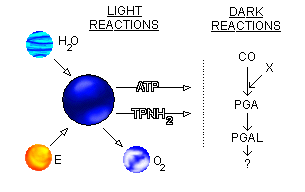 Take
a careful look at the illustration above, which shows the process of carbon
dioxide fixation to the second reaction (along with the light reactions).
Take
a careful look at the illustration above, which shows the process of carbon
dioxide fixation to the second reaction (along with the light reactions).
3. Where does the additional hydrogen in PGAL come from?
Click here to check answer. click
]
In this second reaction of carbon dioxide fixation, PGA acquires hydrogen from NADPH2 to become PGAL. The process regenerates NADP, a substance you already met in the light reactions. You should remember that NADP acquired hydrogen atoms to become NADPH2 the carrier molecule, during the process of (click one):
Consider the "life cycle" of NADP in the process of photosynthesis. It is (click one):- a. reactant in the light reactions and a product in the dark reactions
- b. reactant in the dark reactions and a product in the light reactions
| Reaction #3: | The third reaction produces the final production of both carbon fixation and photosynthesis. |
| Information: | Radioactive investigations give evidence that PGAL is converted into two compounds. One has been identified as ribulose disphosphate (RuDP). The other is carbohydrate. |
| Concept: | PGAL breaks down into two simpler molecules. |
| Process: | PGAL ---> carbohydrate + RuDP |
| Product: | Carbohydrate and RuDP. The carbohydrate is the important product in this reaction! |
4. Why is this a problem?
Click here to check answer. click
Although RuDP is produced in the dark reactions of photosynthesis, it is not a product of the process of photosynthesis. Neither is it a regenerated substance like NADP, which is generated in the dark reactions but consumed in the light reactions . . . or is it?
What happens to the RuDP produced in Reaction 3 of carbon dioxide fixation? The answer is to be found if you examine the entire set of reactions of carbon dioxide fixation. Take a careful look at all three reactions:
- Compound X + CO2 ---> PGA
- PGA ---> PGAL
- PGAL ---> CH2O + RuDP
Answer: RuDP is the "mystery" compound X of Reaction 1. It is
used in Reaction 1.
RDP = RuDP
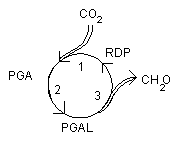 Carbon
dioxide fixation is a process which uses in one reaction what is produced
in another. RuDP is produced in Reaction 3; it is used in Reaction 1. Refer
to the illustration below. Here you can see that the RuDP is cycled back
to be reused in Reaction 1. The RuDP is cycled back to be reused in Reaction
1, but what of the other "cycles" also apparent from the diagram?
Carbon
dioxide fixation is a process which uses in one reaction what is produced
in another. RuDP is produced in Reaction 3; it is used in Reaction 1. Refer
to the illustration below. Here you can see that the RuDP is cycled back
to be reused in Reaction 1. The RuDP is cycled back to be reused in Reaction
1, but what of the other "cycles" also apparent from the diagram?
Cyclic reactions are common phenomena in life processes. The RuDP example is but one of many, some of which you have already seen. Remember that water molecules are regenerated in photolysis. You also saw the regeneration of NADP in the dark reactions after it had been consumed in the light reactions. Study the figure indicated by E-19.
You have examined the fate of the carbon dioxide from the time it enters into the dark reactions until it is fixed into a molecule of carbohydrate. You have also seen the fate of the NADPH2 from the time it was produced in the light reactions, through the carrying of the hydrogen to the dark reactions, and the final use of the hydrogen to make a carbohydrate molecule. The production of carbohydrate is complete.
Look back now at the illustration at the top of this document. What product of the light reactions is still unaccounted for?
Answer: ATP
Study the figure indicated by E-20. You will remember that ATP was produced during the light reactions by two different processes, both of which transformed light energy into chemical energy. You might well ask about the fate of this ATP in the dark reactions.
ATP can be thought of as a carrier molecule, much as NADPH2 is a carrier molecule. ATP carries two things, a phosphate group (P) and energy. During the dark reactions ATP deposits both its _____ and its _____ into dark reactions.
Answer: energy; phosphate group (in either order)
Some energy from the light reactions is transferred to the carbohydrate molecule in this reaction:
The energy required to drive Reaction 3 is made available to the cell by ATP molecules. These molecules are formed during the (light/dark) reactions, and their energy is released during the (light/dark) reactions. 16. The energy stored in ATP molecules during the light phase of photosynthesis is made available as ATP is converted to ADP and phosphate. What is the eventual fate of this energy? (Click one.)
- a. It escapes to the environment.
- b. It becomes a part of the RuDP produced in carbon dioxide fixation.
- c. It is stored in the carbohydrate product of photosynthesis.
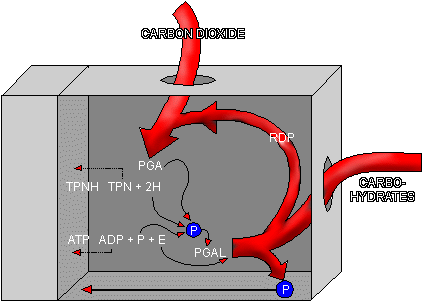
The illustration shows that the phosphate enters the dark reaction cycle and then is released to be used again in the production of ATP molecules. In reality, phosphate is much more actively involved in the dark reactions than is apparent in this illustration. The phosphate actually enters the cycle at several points and takes part in numerous reactions which have not been included in the description of photosynthesis presented in this book. Our purpose is to give you an overall understanding of the processes without confusing you with extensive details. To achieve this end, many of the complex chemical reactions that occur have been somewhat simplified in order to better explain the process. Many reactant/product expressions you have learned are actually composites of several additional chemical reactions. You can consult other books for more detailed explanations or reactant/product expressions for the individual reactions known.
This lesson presents a simplified summary of what scientists now
know about photosynthesis. We have traced the advances in understanding
of the process from the time when scientists thought of plant growth as
a closed box to the present time. Today much is known about the process
of photosynthesis, but much remains to be learned. Some aspects of photosynthesis
can be considered closed box mysteries.
Below is the road map showing the path of carbon as it moves
through the dark reactions or light independent reactions.
Study this pathway and write in your notes. Read the pages indicated by
E- and study the diagram showing the C3 cycle of carbon
fixation in the text.
(5C)
(6C)
(3 C each)
RuDP + CO2 ------>
(6 carbon, unstable) ---> 2 PGA (next line)
(3 C each)
(3 C each)
(requires 2 ATP AND 2 NADPH)
2 PGA ------------------>
2 PGAL----> some (2) to glycolysis in reverse
(6 C)
(5 C)
to form glucose
and the rest recycled back to reform RuDP.
Note: RuDP contains 5 carbons and carboxylated into 2 PGA which
have a total of 6 carbons. The two PGA molecules are reduced (requires
energy) into 2PGAL which have a total of 6 carbons. At this point
the PGAL may go to one of two pathways. One of the pathways is for two
of the PGAL going to glycolysis, moving through this pathway
in reverse forming one molecule of glucose. Also some of the
PGAL can be recycled back to form RuDP. This latter pathway requires the
use of one ATP per RuDP.
Recall that in the formula for photosynthesis six carbon dioxides were reduced into glucose.
Now let us balance the road map above by adding six carbons of carbon
dioxide. Of course you would need six molecules of RuDP. Check your answer
below.
(5 C each)
(6 C each)
(3 C each)
6 RuDP + 6 CO2 ------>
6 (6 carbon, unstable) ---> 12 PGA (next line)
(3 C each)
(3 C each)
(requires 12 ATP AND 12 NADPH)
12 PGA ------------------>
12 PGAL----> some (2) to glycolysis in reverse
(6 C)
(requires 6 ATP) (5 C each)
to form glucose
and the rest (10) recycled back to reform RuDP.
Focus on the number of carbon atoms. Your started with
30 carbon atoms in the RuBP molecules which picked 6 carbons from
carbon dioxide molecules to form
12 PGA with a total of 36 carbon atoms. The 12 PGAl molecules
also contain 36 carbon atoms. Two of the PGAl molecules (6 carbon atoms)
enters into glycolysis and move through it in reverse to form
one glucose molecule which contains 6 carbon atoms. This leaves 10
PGAL with a total of 30 carbon atoms to recycle back to reform 6
RuDP with 30 carbon atoms.
Determine the amount of energy required to synthesize one glucose molecule from the road map above.
5. Where does this energy come from?
Click here to check answer. click
To test how much you do know about photosynthesis, the illustration below combines into one diagram all the reactions which you have studied. Each step in the process should now make sense to you. Examine the diagram carefully. If you locate reactions or steps which you do not feel sure about, read the portions of the pages which relate to them before you read on. TPNH2 = NADPH
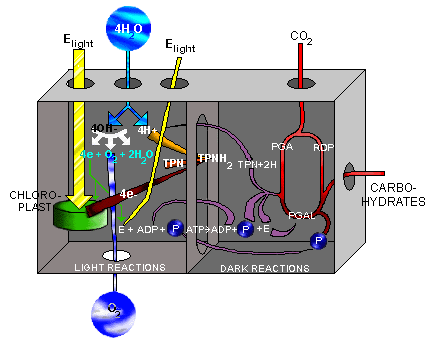
You have studied the mechanisms of photosynthesis in considerable detail. We hope you have not become so involved in learning these details that you have forgotten the importance of the process to all living things on earth. Remember, it is photosynthesis which supplies, however indirectly, all of the chemical energy needed for survival of living things.
6. Photosynthesis produces two molecular products-oxygen gas and carbohydrate. Which is the important chemical energy product of photosynthesis?
Click here to check answer. click
The process of photosynthesis enables plant cells to transform light energy into chemical energy in the form of carbohydrate molecules. Plants use the light energy to produce high- energy molecular arrangements. Here is the reactant/product formula for this reaction and the energy diagram of the process:
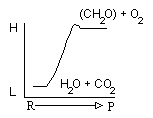
The formula CH2O is the generalized formula for all carbohydrates. Plant cells can produce a number of different carbohydrate molecules by means of photosynthesis. You will remember that carbohydrates include sugars, starches, and cellulose. Generally the reactant/product expression for the process of photosynthesis is written as an equation for the production of the most common sugar produced glucose. The equation is:
Plants generally use the glucose formed by photosynthesis as
raw material to make other carbohydrates. Additionally, plants can use
carbohydrates to produce amino acids, fats, proteins, vitamins, and all
other materials needed by cells for growth and reproduction.
7. Clearly, the process which enables the formation of all other
organic compounds
by plants is _____.
Click here to check answer. click
Plants use the carbohydrate products of photosynthesis both as raw materials for other organic compounds and as source of energy needed for conducting life processes. Plants are consumers of the food (high energy carbohydrates) that they make themselves. Although animals cannot make their own food from inorganic materials as plants do, animals can consume plants (or other animals) as food.
So, all life forms are dependent upon photosynthesis, the process that transforms inorganic materials into high energy carbohydrates. By means of photosynthesis, energy from sunlight is made available for use by living things in the form of food. All living things depend on food for the chemical energy necessary to maintain their organizations and to perpetuate themselves. Without obtaining chemical energy, no living creature can survive.
Recall the equation for photosynthesis you learned earlier:
After learning the light dependent reactions (dark), you
can rewrite the equation above as follows:
Elight (chlorophyll)
ADP + NADP +6CO2 +
6H2O + ----> 6O2 + 6C6H12O6
+ ATP + NADPH
Using the same equation include the amount of energy required per glucose molecule. .
Elight (chlorophyll)
18ATP + 12 NADPH +6CO2 + 6H2O
+ ----> 6O2 + 6C6H12O6
+ 18 ADP + 12 NADPH
Note and explain the changes and write in our notes.
This is the end of the lesson of the dark reactions. Click
here to go back to the home page and the next lesson - C3
pathway.
1. The dark reactions or light independent reactions do not directly
require light; however, these reactions are going to require
the energy formed during the light reactions. Therefore both the dark (ATP,
NADPH) reactions and light reaction occur during the day and both shut
down at night.
Press here to go back to web page. press
2. PGA, this is the first product of the dark reactions.
PGA is a three carbon molecule.
Press here to go back to web page. press
3. Hydrogen comes from the NADPH2 formed in the light reactions.
Press here to go back to web page. press
4. RuDP is not a product of photosynthesis, yet it is produced
along with the expected product.
Press here to go back to web page. press
5. The amount of energy to form one glucose molecule is 18 ATP and 12
NADPH. This energy is formed during the light reactions. Both the light
and dark reactions can work independently of one another; however, the
dark reactions do require ATP and NADPH which may be formed during the
light reactions.
Press here to go back to web page. press
6. Both are important. Glucose provides a carbon source for not only the plants themselves but all heterotrophs which feed off of them. Oxygen is a by product; however both plants and animal use this product during cellular respiration.
Press here to go back to web page. press
Press here to go back to web page. press
8.
Press here to go back to web page.
9.
Press here to go back to web page.
10.
This is the end of lesson twelve . Click here to
go back to the home page and lesson thirteen: C-3 Plants.
click
Created by the Multimedia Development Lab, Academic Technology Services.
Last modified October 29, 1997.